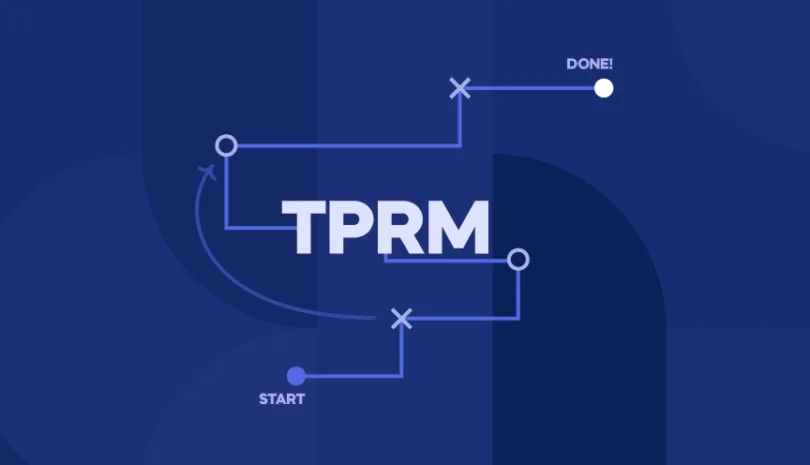Every organization today relies on outside vendors, whether it’s for cloud storage, payroll, or specialized software. That reliance comes with benefits, but it also creates new risks. If a vendor fails to protect sensitive data or meet regulatory standards, the consequences often fall back on the business that hired them. That’s why vendor due diligence has become such an essential part of third-party risk management (TPRM).
One of the most effective ways to evaluate a vendor’s security and compliance practices is through their SOC (Service Organization Control) reports. SOC 1 reports give insight into financial reporting controls, while SOC 2 reports go deeper into areas like security, availability, and confidentiality. Together, they provide independent validation of a vendor’s internal controls and can be a powerful tool for risk teams.
In this article, we’ll look at how to make the most of SOC reports during vendor due diligence, covering the basics of what they include, how to review them effectively, the common mistakes to avoid, and how they fit into a broader TPRM strategy.
What Are SOC Reports?
SOC (Service Organization Control) reports are independent audits that evaluate how well a vendor safeguards data and manages internal controls. There are three main types: SOC 1 (focused on financial reporting controls), SOC 2 (focused on security, availability, processing integrity, confidentiality, and privacy), and SOC 3 (a lighter version of SOC 2 intended for public sharing).
SOC reports also come in two forms: Type I, which provides a snapshot of controls at a single point in time, and Type II, which evaluates the effectiveness of those controls over a longer period, typically six to twelve months. For due diligence, Type II reports are far more valuable since they show how consistently a vendor operates their controls.
A key element of SOC 2 is the Trust Services Criteria, which outlines the five pillars of a secure and reliable service: security, availability, processing integrity, confidentiality, and privacy. Among the three report types, SOC 2 is most frequently used in third-party risk management because it directly addresses the safeguards that protect sensitive data and ensure operational resilience.
Why SOC Reports Matter in Third-Party Risk Management
When organizations bring in new vendors, they often face the challenge of verifying whether those vendors have adequate safeguards in place. SOC reports provide independent validation from external auditors, making them one of the most trusted tools in the due diligence process.
Beyond showing that controls exist, SOC reports also serve as evidence of a vendor’s commitment to security and compliance. This is particularly important for industries bound by strict regulations such as GLBA, HIPAA, GDPR, and SOX. By reviewing a vendor’s SOC report, companies can demonstrate to regulators and stakeholders that they’ve taken steps to evaluate risk before sharing sensitive data or systems.
Equally important, SOC reports help identify weaknesses early in the procurement process. Exceptions or control gaps flagged in an audit give TPRM teams a chance to ask questions, request remediation, or decide whether the vendor poses too much risk. In short, SOC reports are not just paperwork; they’re a critical layer of assurance in building safe, resilient partnerships.
Best Practices for Using SOC Reports in Due Diligence
SOC reports are only valuable if they’re reviewed thoughtfully and applied consistently. Rather than treating them as a “checkbox,” TPRM teams should use SOC findings to make informed, risk-based decisions about vendors. That means asking for the right type of report, carefully reviewing scope and results, and tying the findings back to your own security and compliance requirements. Below are practical best practices to help you maximize the value of SOC due diligence and integrate it into a broader third-party risk management program.
Request the Right Report
The first step is knowing which SOC report to request. If the vendor’s services impact your financial reporting, a SOC 1 may be appropriate. If they handle sensitive data or provide critical IT services, a SOC 2 is often the better choice. In some cases, both may be relevant. Always ask for the most recent Type II report, since it demonstrates how controls perform over time, rather than a single point in time. A current, Type II SOC 2 is typically the strongest evidence you can obtain during vendor due diligence.
Review the Report Scope Carefully
Not every SOC report will cover what you need. Pay close attention to the reporting period (to ensure it’s current), the systems and services included, and the control categories assessed. Some reports may exclude services you rely on, or cover only part of the vendor’s environment. Confirm that the systems relevant to your business are in scope before you rely on the findings. Scope misalignment is one of the most common mistakes TPRM teams make when reviewing SOC reports.
Assess the Auditor’s Independence and Reputation
A SOC report is only as reliable as the auditor who prepared it. Verify that the assessment was performed by a credible, independent third-party audit firm. Look for auditors with strong reputations in the industry, ideally with experience in IT security and regulatory compliance. A lesser-known or affiliated auditor may raise questions about independence or quality. Confidence in the auditor adds confidence in the vendor’s controls.
Pay Close Attention to Exceptions and Control Failures
The most valuable insights often lie in the testing results section of the SOC report. Here, auditors document control deviations, exceptions, or qualified opinions. Don’t gloss over these details; each exception could indicate a risk that affects your organization. Assess whether the issue is minor or if it could meaningfully impact your data security, compliance obligations, or business continuity. If necessary, follow up with the vendor to understand their remediation plan.
Evaluate Complementary User Entity Controls (CUECs)
Every SOC report outlines complementary user entity controls (CUECs) the security measures that your organization is expected to implement for the vendor’s controls to remain effective. For example, if the vendor assumes you enforce strong password policies, you must confirm those controls exist internally. Overlooking CUECs can lead to false assurance, since the SOC report’s effectiveness depends on both parties doing their part.
Map SOC Controls to Your Own Risk Criteria
To get the most from a SOC report, map its findings against your internal risk rating system or compliance framework (e.g., NIST CSF, ISO 27001, or your company’s vendor risk scoring model). This alignment helps translate a vendor’s control effectiveness into language your risk committee, compliance officers, and business stakeholders understand. By making this connection, you can demonstrate how SOC due diligence supports enterprise-wide risk management.
Document the Review and Risk Decisions
Finally, ensure your SOC report review process is well-documented. Record how the report was assessed, what risks were identified, and what decisions or mitigation steps were taken. Keep evidence in your TPRM system for audit readiness and accountability. This documentation not only proves due diligence but also provides a reference point for future reviews or vendor reassessments.
Using SOC Reports in Ongoing Due Diligence
SOC reports shouldn’t be treated as a “one-and-done” exercise during vendor onboarding. To be effective, they need to be part of ongoing due diligence. At a minimum, review each vendor’s SOC report annually or during contract renewals, ensuring that it remains current and relevant. Pay special attention to changes in scope or control coverage; a new system, cloud service, or business unit may introduce risks that weren’t evaluated in the prior report.
It’s also important to compare findings from year to year. Look for trends: has the vendor remediated past issues, or are the same exceptions appearing repeatedly? Persistent control failures could signal weak governance or a lack of accountability. Finally, don’t stop at reading the report; follow up with vendors to confirm that remediation plans are in motion and that exceptions are being addressed. By building SOC reports into ongoing monitoring, you turn them from static documents into living tools that strengthen your third-party risk management program over time.
Common Mistakes to Avoid While Using SOC Reports
While SOC reports are a powerful due diligence resource, they’re often misunderstood or misused. A common mistake is relying on the report alone without considering the broader context of the vendor’s risk profile. SOC reports are one piece of the puzzle, not a full picture.
Another pitfall is skimming only the summary or auditor’s opinion. The real insights are often buried in the details of the control testing and exceptions. Equally risky is ignoring complementary controls (CUECs), which can create a false sense of security if your organization doesn’t meet its own responsibilities.
Finally, many teams treat SOC reports as static, one-time documents rather than part of an ongoing process. Risks evolve as vendors grow, adopt new technologies, or expand services. Without periodic reviews, organizations can miss emerging risks. Avoiding these mistakes ensures SOC due diligence delivers meaningful protection instead of becoming a compliance checkbox.
Final Thoughts: Enhancing TPRM with SOC Due Diligence
SOC reports have become one of the most practical and widely recognized tools for vendor risk assessment. They provide independent assurance that a vendor’s internal controls are functioning as intended, while also giving security and risk teams valuable insight into potential weaknesses. But their value goes beyond risk reduction; asking for and reviewing SOC reports also signals to vendors that security and compliance are taken seriously, strengthening accountability in the relationship.
To get the most out of SOC due diligence, organizations should make SOC review a core part of their TPRM process, not just an optional step. This means incorporating SOC analysis into onboarding, annual reviews, and contract renewals, while also following up on exceptions and tracking remediation. By applying a proactive, risk-based mindset, SOC reports shift from being static compliance documents to active tools that help organizations protect data, meet regulatory expectations, and build stronger vendor partnerships.
Ready to strengthen your vendor due diligence program? Book a personalized demo with Panorays to see how our platform streamlines SOC report reviews and elevates your TPRM process.
SOC Reports as a Due Diligence Tool FAQs
-
SOC reports offer independent validation of a vendor’s internal controls. They give risk teams a trusted view into how well a vendor protects sensitive data, maintains availability, and meets compliance requirements.
-
No. SOC reports are valuable, but they should be combined with other due diligence measures, such as security questionnaires, continuous monitoring, and regulatory compliance checks. On their own, they don’t provide a full picture of vendor risk.
-
Typically, no. SOC 1 and SOC 2 reports are considered confidential and are shared only under non-disclosure agreements. SOC 3 reports, however, are designed for public distribution and can sometimes be found on a vendor’s website.
-
SOC reports should be reviewed annually or at contract renewals. Organizations should track changes in scope, watch for recurring exceptions, and confirm that vendors remediate identified issues. This makes SOC due diligence an ongoing process rather than a one-time exercise.



